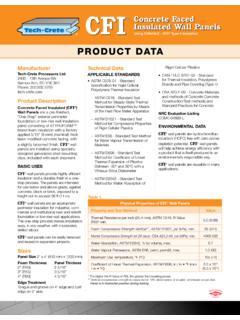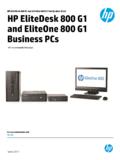Transcription of ClickShare, Connecting to LAN - starin.info
1 clickshare , Connecting to LAN The clickshare web interface contains three tab pages: Setup, Maintenance and Help. If you cannot find the IP address ( there is no screen available to connect to the DVI output) you should connect to the Base Unit directly with your laptop via an Ethernet crossover cable and access the web interface using the fixed IP address Make sure your own LAN adapter is set in the range. Accessing the clickshare Web Interface Getting access to the Web Interface There are three ways to access the clickshare Web Interface: 1. Via the LAN 2. Via a crossed cable 3. Via the Base Unit wireless network To access the Web Interface via the LAN 1. Open a browser. Note: Supported browsers are Internet Explorer, Firefox, Google Chrome and Safari. 2. Browse to the IP address you can find in the top left corner of the clickshare welcome screen. Note: The IP address is only visible when the Base Unit is connected to the LAN.
2 A login screen appears. 3. Enter the user name admin and the password and click OK. By default, the password is set to admin . The web interface opens. To access the Web Interface via a crossed cable: 1. Connect the Base Unit to your laptop using a crossed cable. 2. On your laptop, open a browser. Supported browsers are Internet Explorer, Firefox and Safari. 3. Browse to A login screen appears. 4. Enter the user name admin and the password and click OK. By default the password is set to admin . 5. The web interface opens. Web Interface To access the Web Interface via the Base Unit wireless network 1. On your laptop, connect to the Base Unit wireless network. 1. The default SSID and password to connect to the Base Unit are respectively clickshare -<serial base number> and clickshare . 2. On your laptop, open a browser. 3. Note: Supported browsers are Internet Explorer, Firefox and Safari.
3 4. Browse to 5. A login screen appears. 4. Enter the user name admin and the password and click OK. 6. By default the password is set to admin . The web interface opens. To access the Web Interface via the Base Unit wireless networks when SSID is not broadcasted. One important thing: the SSID of the zero units is not broadcasted. This means that it doesn t appear in your list of wireless networks. If you want to connect to it, it depends on your operating system how to proceed (there are tutorials online for Windows XP and Windows 7). The SSID of the base unit has the format clickshare -<serialnumberbaseunit> , password is still clickshare . clickshare -123456789 Windows XP, locate or hide wireless networks. 1. Click the on the Start button and select Control Panel. 2. Double-click on Network Connections. 3. Right-click on Wireless Network Connection and select Properties.
4 4. Select the Wireless Networks tab. Be sure the option Use Windows to configure my wireless network settings is checked and then click on the Add button. 5. Enter your network settings: a. Network name (SSID) b. Use the drop-down menu and select your security level (Open for no security, or WEP, WPA, or WPA2). c. Uncheck The key is provided for me automatically. (This enables you to input your encryption key/passphrase.) d. Click on OK. 6. Confirm your network is listed in Preferred Networks and click on OK. 7. For more details, go to ~/how-do-i-connect-to-a-hidden-wireless- network-in-windows-xp%3F Windows 7, locate or hide wireless networks. 1. To do this, you need to open the Network and Sharing Center 2. Click on the one that says 'Set up a new connection or network'. 3. From the list of available options, select 'Manually connect to a wireless network' and click on Next.
5 4. Now you will have to complete all the fields shown in this window. The first one is called Network name which is the equivalent of the Network ID (SSID) NOTE: If your wireless network has no security enabled, then select No authentication (Open). 5. If you are in a public environment, select Hide characters' box. 6. Check the other two boxes: 'Start this connection automatically' and 'Connect even if the network is not broadcasting'. 7. When done, Windows 7 will automatically connect to the hidden wireless network. For more details, go to Changing the administrator password You can change the administrator password at any time. To change the administrator password 1. Go to the clickshare web interface. 2. Click the Maintenance tab and click Password. The Password tab page is displayed. 3. Enter the old password. 4. Enter the new password. 5. To confirm, enter the new password a second time.
6 6. Click Apply. The administrator password has been changed. Changing the logging settings On the web interface it is possible to change the local and remote logging settings. Local logging means the log file is saved on the Base Unit itself. To change the local and remote logging settings 1. Go to the clickshare web interface. 2. Click the Maintenance tab and click Logging. The Logging tab page is displayed. 3. If needed, adapt the local logging settings: - enable or disable debug logging - download the log file - clear the log file 4. Enable or disable remote logging: 5. To confirm your changes, click Apply. The new logging settings are now in use. clickshare Help You can find information on your clickshare product, Barco contact data and the End-User License Agreement (EULA) on the Help tab page of your clickshare web interface. Consulting the Barco contact data If a problem occurs while using your clickshare product, you can contact service for help.
7 On the Contact tab page of the web interface, you can find the clickshare contact data. To consult the Barco contact data 1. Go to the clickshare web interface. 2. Click the Help tab and click Contact. The Contact tab page is displayed. On the Contact tab page you can find: - a link to the clickshare home page - a link to the clickshare online help - a link to an online version of the frequently asked questions - the contact data of the helpdesk (website and telephone number) in case of problems
![JCA22H SERVICE MANUAL[1] - Starin](/cache/preview/e/4/1/3/d/8/0/4/thumb-e413d8043a030452c20829c3366ebb0a.jpg)





